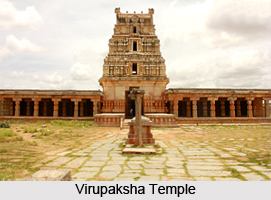 Badami Chalukya Architecture was initially seen in the area of Malaprabha basin, in present day Bagalkot district of North Karnataka. This style is also known as Vesara style and Chalukya style. Earliest temples of this architecture date back to around 450 A.D.in Aihole when the Badami Chalukyas were feudatories of the Kadambas of Banavasi.
Badami Chalukya Architecture was initially seen in the area of Malaprabha basin, in present day Bagalkot district of North Karnataka. This style is also known as Vesara style and Chalukya style. Earliest temples of this architecture date back to around 450 A.D.in Aihole when the Badami Chalukyas were feudatories of the Kadambas of Banavasi.
The Chalukya style had originated in Aihole and was brought to perfection in Badami. Badami cave temples are striking examples of architecture of Badami chalukyas.
Badami cave temples have rock cut halls with pillared veranda, columned hall and a sanctum cut out deep into rock. Rock cut halls were also experimented in Aihole where they built three cave temples, each one in Vedic, Buddhist and Jaina styles. Later the styles were refined and four marvellous cave temples at Badami were constructed.
The running frieze of Ganas in various postures caved in relief on each plinth is a striking feature of these rock cut cave temples.
The verandas of the cave temples are comparatively plain however the inner hall contains rich sculptural symbolism. The finest structural temples are located in Pattadakal in Karnataka. Among the ten temples of Pattadakal, six are in Dravidian style and four in Rekhanagara style. The main sanctum has a Pradakshinapatha and mandapa. The mandapa is pillared and has pierced window screens. The external wall surface is divided into well-spaced ornamental niches that are abundant with either sculptures or perforated windows. The serene art of the Badami Chalukya reappeared in the pillared architecture of the Vijayanagar Empire. Some of the important Badami Chalukya temples are:
* Temples at Pattadakal
* Virupaksha Temple
* Sangameshvara Temple
 * Mallikarjuna Temple
* Mallikarjuna Temple
* Galganatha Temple
* Kadasiddeshvara Temple
* Jambulinga Temple
* Papanatha Temple
* Naganatha Temple
* Chandrashekara Temple
* Mahakuteshwara Temple
* Aihole
* Lad Khan Temple
* Huchiappayyagudi Temple
* Huchiappayya math
* Durga Temple
* Meguti Jain Temple
* Ravanaphadi Temple
* Gowda Temple
* Suryanarayana Temple
* Badami cave temples
Cave 1 (Shiva)
Cave 2 (Vishnu as Trivikrama or Vamana, Varaha and Krishna)
Cave 3 (Vishnu as Narasimha, Varaha, Harihara and Trivikrama.)
Cave 4 (Jain Tirthankara Parsvanatha)
* Bhutanatha group temples (Badami and Kalyani Chalukya)
* Gerusoppa
* Vardhamanaswamy Temple
* Nava Bhrama temples (Badami Chalukya)
In the history of Indian architecture the period of Badami Chalukyas was a glorious era. Badami Chalukyas established the cave temple architecture on the banks of the Malaprabha River between 500 and 757 AD. They were built out of sandstone cut into enormous blocks. Aihole has around 150 temples scattered around the village. The Ladkhan temple is the oldest among them. The Durga Temple is also notable for its semi-circular apse and the gallery that encircles the sanctum sanctorum. Other temples include Hutchimali Temple, Konthi temple and the Meguti Jain temple.




